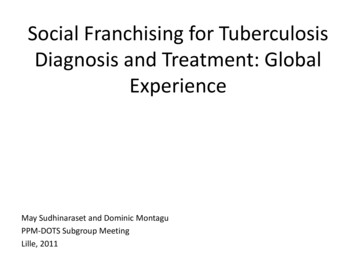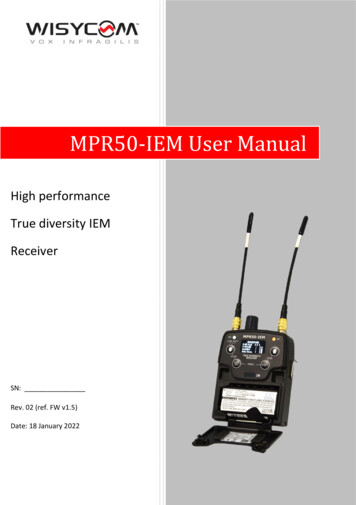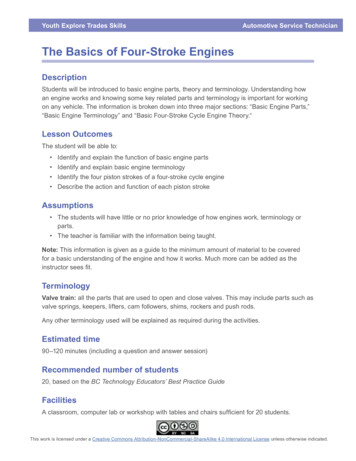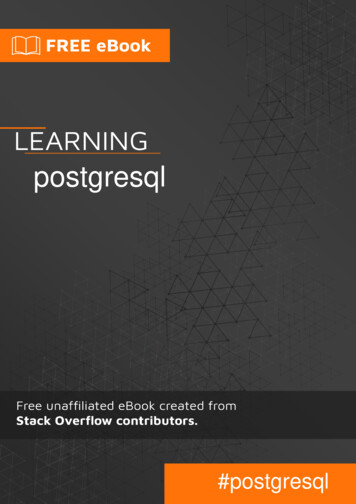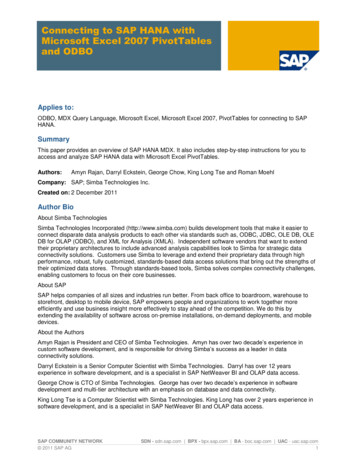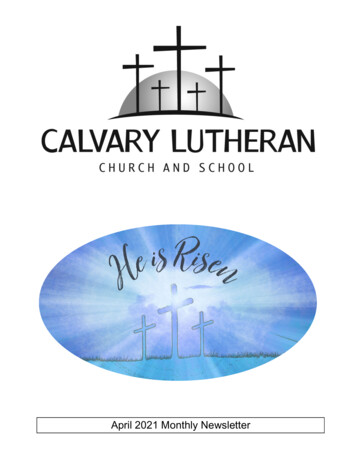
Transcription
Connecting the Dots:A Resource Guide forMeeting the Needs ofExpectant and ParentingYouth, their Children, andtheir Families
Table of ContentsIntroduction . . . . . . . . . . . . . . . . . . . . . . . . . . . . . . . . . . . . . . . . . . . . . . . . . . . . . . . . . . . 3Methodology . . . . . . . . . . . . . . . . . . . . . . . . . . . . . . . . . . . . . . . . . . . . . . . . . . . . . . . . . . . 4How to Read This Guide . . . . . . . . . . . . . . . . . . . . . . . . . . . . . . . . . . . . . . . . . . . . . . . 5Parenting, Coparenting, and Fatherhood SupportsPrograms, Interventions, and Training Curricula . . . . . . . . . . . . . . . . . . . . . 7Preparation for Adulthood, including Education,Housing, and EmploymentPrograms, Interventions, and Training Curricula . . . . . . . . . . . . . . . . . . . 43Sexual and Reproductive Health ServicesPrograms, Interventions and Training Curricula . . . . . . . . . . . . . . . . . . . . 56Mental Health ServicesPrograms, Interventions, and Training Curricula . . . . . . . . . . . . . . . . . . . . 72Substance Abuse ProgramsPrograms, Interventions, and Training Curricula . . . . . . . . . . . . . . . . . . . 82Other Related ResourcesFact Sheets, Reports, Toolkits, and Guides . . . . . . . . . . . . . . . . . . . . . . . . . 88AppendicesAppendix A: California Evidence-Based Clearinghouse forChild Welfare (CEBC) . . . . . . . . . . . . . . . . . . . . . . . . . . . . . . . . . . . . . . . . . . . . . . . . . . . . . . . . 93Appendix B: Coalition for Evidence-Based Policy . . . . . . . . . . . . . . . . . . . . . . . . . . 95Appendix C: Department of Health and Human Services,Home Visiting Evidence of Effectiveness (HomVEE) . . . . . . . . . . . . . . . . . . . . . . 96Appendix D: Healthy Communities Institute . . . . . . . . . . . . . . . . . . . . . . . . . . . . . . . 97Appendix E: Promising Practice Network (PPN) . . . . . . . . . . . . . . . . . . . . . . . . . . . 98Appendix F: Child Trends . . . . . . . . . . . . . . . . . . . . . . . . . . . . . . . . . . . . . . . . . . . . . . . . . . . .99Appendix G: County Health Rankings and Roadmaps . . . . . . . . . . . . . . . . . . . . 100Appendix H: HHS Teen Pregnancy Prevention Evidence Review . . . . . . . . 101Appendix I: Clearinghouse for Military Readiness . . . . . . . . . . . . . . . . . . . . . . . . 102Appendix J: Social Programs that Work . . . . . . . . . . . . . . . . . . . . . . . . . . . . . . . . . . . 103The information presented in this publication is for resource purposes only. The Center forthe Study of Social Policy does not specifically recommend any of the programs included.CSSPConnecting the Dots: A Resource Guide for Meeting the Needs of Expectant and Parenting Youth, their Children, and their FamiliesPage 2
IntroductionExpectant and parenting youth in foster care (EPY)—both mothers and fathers—face the dual challenge oftransitioning into adulthood while learning to parent andmeet the needs of their children. Unfortunately, littleattention has been paid to their experiences and uniqueneeds; few programs target them specifically; and scantresearch exists evaluating the effectiveness of services.As a result, policymakers, child welfare administrators, andpractitioners lack information about evidence-informedinterventions that improve well-being outcomes for theseyoung families and their children.The Family First Prevention Services Act (FFPSA) includespregnant* and parenting youth as a population that iseligible for the new funding prevention services, presentingchild welfare systems with an exciting opportunity to bothre-envision and re-shape service provision and advanceequity in support of these young families. Given that thepercentage of EPY in foster care is higher than in the generalpopulation, it is vital that states are able to better servethese young families so that they can succeed and thrive.Addressing the unique needs of EPY, preventing childabuse and neglect of their children, and reducing disparateoutcomes requires child welfare systems to provideequitable access to a wide range of evidence-informedand trauma-informed services that are responsive to thedevelopmental needs of both young parents and theirchildren. Furthermore, considering children and families ofcolor are disproportionately represented in the child welfaresystem, and acknowledging that young parents may alsoidentify as LGBTQ, it is critical to ensure that all aspects ofyoung parents’ identities, including race, ethnicity, sexualorientation, gender identity and expression, immigrationstatus, and disability are acknowledged, considered, andsupported through service provision.The three purposes of this guide are to: 1) provide acomprehensive set of resources for jurisdictions workingto achieve safety, permanency, and well-being for theseyoung families; 2) enhance knowledge of evidenceinformed and promising practices that holistically addressthe developmental needs of expectant and parentingyouth in foster care, their children, and families; and 3) buildevidence for effective interventions that are informed byand specifically target EPY.This guide provides child welfare administrators,policymakers, and researchers with information on a widerange of interventions that meet the comprehensive needsof EPY, prevent child abuse and neglect of their children, andimprove parent and child well-being outcomes. It includesmost of the initial services listed in the recent federal ProgramInstruction on Title IV-E Prevention Program Requirementsto be considered by the Title IV-E Prevention ServicesClearinghouse. It also includes information about programsthat extend beyond interventions that are directed at buildingparenting skills and capacity and the treatment and preventionof mental health and substance use (which are the programsthat will be allowable for federal reimbursement underFFPSA) and includes information on interventions relatedto education, employment, stress reduction, social support,healthy coparenting relationships, and sexual and reproductivehealth. Given the disparate outcomes experienced by childrenand families of color in the child welfare system, this guidespotlights services that are culturally relevant and nuanced inmeeting the needs of expectant and parenting youth of color,their children, and their families. This allows jurisdictions theflexibility to identify and implement a continuum of serviceswithin diverse settings and communities that meet the needs ofall EPY and proactively address barriers to equity wherever theyoccur. Some interventions will be easier to implement by childwelfare agencies while others will require the creation of newpartnerships with schools, public health, early childhood andeducation, and other public, private, and community resources.This guide, by showcasing programs that are evidencebased, informed, and promising, encourages child welfareadministrators, policymakers, and researchers to invest inbuilding the evidence base for interventions to meet theneeds of their EPY. Through FFPSA, states are now required toimplement evaluation and fidelity plans for all evidence-basedprevention services included in a state’s Title IV-E PreventionPlan.** In addition to building the evidence for programs throughthese evaluations, states may also chose to utilize Maintenanceof Efforts dollars or other state and local dollars to build theevidence for programs that do not currently meet the evidencebased criteria as outlined by the Clearinghouse. Learn more here.These programs can be supported and evaluated using anagency’s existing continuous quality improvement efforts.Priority should be given to research and interventions thatauthentically center the voices of EPY and actively engagethem in the development and improvement of services.This guide is an essential first step in collaborating with childwelfare systems to better align funding, service provision,decision-making, and research with the needs of EPY, theirchildren, and their families.* We use the word “pregnant” here because it is the language used in the bill; we understand that, in some states, the definition of pregnant includes expectant fathers.** The Secretary may waive this requirement for the evaluation of well-support programs.CSSPConnecting the Dots: A Resource Guide for Meeting the Needs of Expectant and Parenting Youth, their Children, and their FamiliesPage 3
MethodologyCSSP’s process of gathering information for this guidecomprised of the following inquiries:First, we searched the major clearinghouses and otherevidence-informed practice websites including:Blueprints for Healthy YouthDevelopmentCalifornia Evidence-BasedClearinghouse for Child Welfare (CEBC)Campbell CollaborationCenter for the Study of Prevention ofViolenceChild TrendsCounty Health Rankings and RoadmapsHealthy Teen Network’s Evidence-BasedEvidence ReviewInstitute of Education ServicesNational Guideline ClearinghouseNational Resource Center for CommunityBased Child Abuse Prevention NationalResponsible Fatherhood ClearinghouseOJJDP, Model Programs GuidePennsylvania State University,Clearinghouse for Military FamilyReadinessResource CenterPew’s Results First ClearinghouseHHS, Home Visiting Evidence ofSAMSHA National Registry of Evidence-Effectiveness (HomVEE)based Programs and PracticesHHS, Teen Pregnancy PreventionWhat Works ClearinghouseSecond, we conducted a general Internet search for resourcesspecifically designed to serve expectant and parenting youth infoster care, their children, and families.CSSPConnecting the Dots: A Resource Guide for Meeting the Needs of Expectant and Parenting Youth, their Children, and their FamiliesPage 4
How To Read ThisResource GuideThe resource guide is organized into the followingcategories:1. Parenting Supports, including Coparenting andFatherhood;2. Preparation for Adulthood, including Education,Housing, and Employment;3. Sexual and Reproductive Health Services;4. Mental Health Services; and5. Substance Abuse Programs.For the purposes of this guide we have defined evidence-informedas programs, interventions, and curricula that were developedbased on theory and for which sufficient data has been collected todetermine effectiveness. This definition is inclusive of those effortsthat have been determined to be evidence-based through randomizedcontrol trial research design. Evidence-informed draws on the bestavailable data findings from theory, research, evaluation, and practiceto determine effectiveness and guide design and implementation.Promising practices are defined as programs, interventions, initiatives,and curricula that were developed based on theory or research,but for which insufficient data have been collected to determinethe effectiveness of the practice. It is our hope that the promisingpractices will be reviewed and evaluated by experts, researchers, andacademics to generate on-the-ground learning and evidence to informand provide guidance on impact, replication, and scalability.CSSPConnecting the Dots: A Resource Guide for Meeting the Needs of Expectant and Parenting Youth, their Children, and their FamiliesPage 5
Each entry includes the following information:1.Name of the program, initiative, and curriculum. All of the entries listed in this guideserve expectant and parenting youth in foster care. Parentheses after each of theprograms describe the primary target population, using the following descriptors: EPY-FC—designed specifically to serve expectant and parenting youth infoster care EPY—designed to serve expectant and parenting youth Foster Youth—designed to serve youth in foster care Youth—designed to serve youth Parents—designed to serve parents Fathers—designed to serve fathers CR—culturally relevantCR2. Results that the program, intervention, and curriculum attempts to achieve include: Children and youth are safe; Children and youth are healthy; Children enter school ready to learn and are prepared to succeed; Youth succeed in their education; Youth are prepared to succeed as adults; Children and youth have healthy and positive social connections; Youth have steady and gainful employment; and Children and youth have safe, stable, and affordable housing3. Target population to be served4. Description of the program5. Source of the evidence-informed clearinghouse that has rated the program,intervention, and curriculum followed by the rating given. Each evidence-informedclearinghouse has its own specific rating system. Detailed information for eachrating system referenced can be found in the appendix.6. Evidence of effectiveness including detailed information of external and/or internalevaluations conducted7. Location of where the program, intervention, initiative, and curriculum areimplemented8. Website source or key contact for more informationThe descriptions of each of the programs, interventions, curricula,and other resources that follow are quoted directly or adapted fromthe programs’ materials and/or other vetted reference sources. Inall cases the citation is clearly listed. For further information aboutthese sources, please contact Lisa Primus at lisa.primus@cssp.org.CSSPConnecting the Dots: A Resource Guide for Meeting the Needs of Expectant and Parenting Youth, their Children, and their FamiliesPage 6
Parenting,Coparenting,and FatherhoodSupports
Healthy Families America– Home Visiting for Child Well-Being - (EPY)Results Children and youth are safe Children and youth are healthyTarget PopulationFamilies with children from birth to age fivewho are at-risk for child abuse and neglectDescriptionHealthy Families America (HFA) is a home visiting program model designed to workwith families with children at-risk for child abuse, neglect, and other adverse childhoodexperiences. HFA services are offered voluntarily, intensively, and over three to five yearsafter the birth of the baby. Home visiting services must be initiated either prenatally orwithin three months after the birth of the baby.The state of Massachusetts adapted the HFA curriculum to serve the specific needs ofexpectant and parenting youth.Source of RatingRatingCEBCWell-Supported by Research EvidenceEvidence of EffectivenessA review of 33 evaluations and 15 studies found that program participants demonstrateda significant improvement in parenting attitudes from baseline to year two. HFAwas also found to reduce the parenting stress of its participants with significantlylower scores indicated on the Parenting Stress Index at year two. The studies wereconducted in ethnically diverse locations. 37 percent of 100 sample sites in nine statesserved predominantly African American families and 21 percent of these sites servedpredominantly Latinx families (Harding et al., 2007).Implementation Site(s)For more e-training/CSSPConnecting the Dots: A Resource Guide for Meeting the Needs of Expectant and Parenting Youth, their Children, and their FamiliesPage 8
Parent-Child Interaction Therapy (Parent)ResultsTarget Population Parents of children age two to six withbehavior and or parent-child relationship challengesChildren and youth are safeChildren and youth are healthyDescriptionParent-Child Interaction Therapy (PCIT) is a dyadic behavioral intervention for childrenand their parents that focuses on decreasing externalizing child behavior problems (e.g.,defiance, aggression), increasing child social skills, cooperation, and improving the parentchild relationship. Parents are taught and practice skills with their child in a playroom whilecoached by a therapist. PCIT is time-unlimited; families remain in treatment until parentshave demonstrated mastery of the treatment skills and rate their child’s behavior as withinnormal limits on a standardized measure of child behavior.Source of RatingRatingCEBCWell-Supported by Research EvidenceEvidence of EffectivenessA randomized control trial published in the Journal of Clinical Child and AdolescentPsychology in 2007 found that parents in the PCIT treatment group improved significantlyon parenting skills taught by the program and the percentage of positive behaviorsshown by the children also increased significantly in comparison to the control group. Theexternalizing behaviors in the treatment group children decreased, their total score on theseveral behavioral indicators improved, and fewer disruptive behaviors were reported.The study was conducted with 30 mothers of children age three to six years old diagnosedwith oppositional defiant disorder (ODD) and developmental disability. The treatmentgroup consisted of 67 percent white, 17 percent African American, 13 percent biracial, and3 percent Latinx participants (Bagner and Eyberg, 2007).Implementation Site(s)For more cting the Dots: A Resource Guide for Meeting the Needs of Expectant and Parenting Youth, their Children, and their FamiliesPage 9
The Incredible Years (Parent)Results Children and youth are safe Children and youth are healthyTarget PopulationAll parents with young childrenDescriptionThe Incredible Years parent training intervention is a series of programs focused onpromoting parent/child relationships, strengthening parenting competencies, andfostering parents’ involvement in children’s school experiences in order to promotechildren’s academic, social, and emotional competencies and reduce conduct problems.Programs for different age groups and skill levels (BASIC and ADVANCE) are available,as well coaching manuals for home visitors. The program can be delivered in a variety ofsettings, including at a family’s home, a community agency, a clinic, or a school.Source of RatingRatingCEBCWell-Supported by Research EvidenceEvidence of EffectivenessA randomized controlled trial published in the Journal of Clinical Child and AdolescentPsychology found that parents and their prekindergarten-aged children with parentalor behavioral problems enrolled in The Incredible Years program had reduced conductproblems, increased maternal engagement, and increased success in implementingpositive parenting strategies compared to the control group that received standard HeadStart services. The study consisted of 882 children and their families in Washington’sPuget Sound. Participants were 51 percent white, 19 percent African American, 10 percentLatinx, 8 percent Asian, and 12 percent mixed race or other (Reid, Webster-Stratton, andBaydar, 2004).Implementation Site(s)For more informationNationwide, ting the Dots: A Resource Guide for Meeting the Needs of Expectant and Parenting Youth, their Children, and their FamiliesPage 10
Nurse-Family Partnership (EPY)Results Children and youth are safe Children and youth are healthyTarget PopulationFirst-time, low-income mothersDescriptionThe Nurse-Family Partnership (NFP) is a prenatal and infancy nurse home visitationprogram that aims to improve the health, well-being, and self-sufficiency of low-income,first-time parents and their children. First-time mothers who are pregnant 28 weeks or lessare eligible to enroll. Nurse home visits continue through the child’s second birthday.Source of RatingRatingCEBCWell-Supported by Research EvidenceEvidence of EffectivenessFindings from randomized control studies conducted in Elmira, New York, Denver,Colorado, and Memphis, Tennessee indicate that mothers who participated in the programwere found to have a reduced number of subsequent births, greater intervals betweenbirths, improved maternal self-sufficiency, fewer child injuries and maltreatment, andincreased school readiness for children. A study conducted in 2010 evaluated longitudinaldata from the Olds et al., randomized control trial of NFP in 1985. Results indicated thatyouth whose mothers participated in the treatment group were less likely to have everbeen arrested or convicted than were those in the comparison group. Girls in the nursevisited group born to high-risk (un-married and low-income) mothers had fewer childrenand were less likely to have received Medicaid than the high-risk girls in the comparisongroup (Eckenrode et al., 2010).Implementation Site(s)For more ship.org/CSSPConnecting the Dots: A Resource Guide for Meeting the Needs of Expectant and Parenting Youth, their Children, and their FamiliesPage 11
Homebuilders (Parent)ResultsTarget Population Families with children at imminent risk ofplacement into, or needing intensive servicesto return from, foster care, congregate carefacilities, psychiatric hospitals or juvenilejustice facilities.Children and youth are safeChildren and youth are healthyDescriptionHomebuilders is an intensive family preservation services treatment program designed toprevent the unnecessary placement of children in foster care, congregate care, psychiatrichospitals or juvenile justice facilities. The program model engages families by deliveringservices in their homes and communities.Source of RatingRatingCEBCSupported by Research EvidenceEvidence of EffectivenessA randomized control trial study published in the Children and Youth Services Review in1996 found that families with children in foster care randomly assigned to receive theHomebuilders program’s services (then in an experimental state) were significantly morelikely to return to their families within the 90-day treatment, had children spending moretime in their own home during the 6 and 12-month follow-up period, and were 23 percentmore likely (47 percent to 70 percent) to remain at home during a 12-month follow-upcompared to families in a control group that received routine services. The study, which tookplace in Utah, had 110 participants, 82.7 percent of which were white (Fraser et al., 1996).Implementation Site(s)For more g/programs ifps.aspCSSPConnecting the Dots: A Resource Guide for Meeting the Needs of Expectant and Parenting Youth, their Children, and their FamiliesPage 12
Triple P – Positive Parenting Program(Parents)ResultsTarget Population Families, including young parents, withchildren birth to age 16Children and youth are safeChildren and youth are healthyCRDescriptionTriple P—Positive Parenting Program is a multi-tiered system of five levels of educationand support for parents and caregivers of children and youth. Developed for use withfamilies from diverse cultural groups, Triple P is designed to prevent social, emotional,behavioral, and developmental problems in children by enhancing their parents’knowledge, skills and confidence.Source of RatingRatingCEBCSupported by Research EvidenceEvidence of EffectivenessA randomized controlled trial published in Prevention Science in 2009 randomly assignedSystem Triple P services or standard treatment options in eighteen counties across theSoutheastern United States based on their similarities in rates of substantiated childmaltreatment, out-of-home placement, and emergency room visits for child maltreatmentrelated injuries. Counties receiving System Triple P services had significantly lower rates inall these measures compared to control counties. The study population of approximately85,000 participants was 31 percent African American and 59 percent unspecified (Prinz etal., 2009).Implementation Site(s)For more m/glo-en/home/CSSPConnecting the Dots: A Resource Guide for Meeting the Needs of Expectant and Parenting Youth, their Children, and their FamiliesPage 13
SafeCare (EPY-FC)CRResultsTarget Population Parents of children birth to age five who areat-risk of child abuse and neglect or parentswith a history of child abuse and neglectChildren and youth are safeChildren and youth are healthyDescriptionSafeCare is an in-home parenting program that provides direct skill training in childbehavior management, home safety, and child health care skills with the overarchinggoals of reducing risk factors to prevent child abuse and neglect. The program consists ofweekly home visits for eighteen to twenty weeks.Source of RatingRatingCEBCSupported by Research EvidenceEvidence of EffectivenessA randomized controlled trial evaluation published in Pediatrics in 2012 showed thatparents accessing SafeCare demonstrated a decrease in child welfare recidivismcompared to a control group, especially among the group that received additionalcoaching. A follow-up study examining acceptability among Native American parentsfound that recipients of SafeCare had higher consumer ratings of cultural competency,working alliance, service quality, and service benefits. The study was conducted in 2012with 2,175 participants in Oklahoma, of whom 67 percent were white, 16 percent wereNative American, 9 percent were African American, and 5 percent were Latinx (Chaffinet al., 2012).Implementation Site(s)For more necting the Dots: A Resource Guide for Meeting the Needs of Expectant and Parenting Youth, their Children, and their FamiliesPage 14
Home Instruction for Parents of PreschoolYoungsters (Parent)ResultsTarget Population Parents with children age three to fiveChildren enter school ready to learn andare prepared to succeedDescriptionHome Instruction for Parents of Preschool Youngsters (HIPPY) is a home-based andparent-involved school readiness program that seeks to support parents who may notfeel sufficiently confident to prepare their children for school. The HIPPY model includesfour distinct features: a developmentally appropriate curriculum; weekly home visits andmonthly group meetings; role play as the method of instruction; and a staffing structurethat includes peer home visitors from the community in which the family is being servedand professional coordinators with sensitivity to the needs of families.Source of RatingRatingCEBCSupported by Research EvidenceEvidence of EffectivenessA nonequivalent control group design study published in the Journal of Early ChildhoodResearch in 2013 examined the effect of participation in HIPPY on the school readinessof children born to young mothers versus children born to older mothers participating inHIPPY. Results of young sample t-tests show that participation in HIPPY equalized resultsfor children born to young mothers and those born to mothers over age 19. These resultssuggest that the curriculum used by HIPPY, which focuses on supporting parents as theirchild’s first teacher, helps to mitigate any potential negative effects of being a child of ayoung mother. The study population consisted of 36 primarily Latinx children in Texas(Brown, 2013).Implementation Site(s)For more .phpCSSPConnecting the Dots: A Resource Guide for Meeting the Needs of Expectant and Parenting Youth, their Children, and their FamiliesPage 15
Parent Together Project (Fathers)ResultsTarget Population First-time parents in the second trimester ofpregnancy through five months postpartumChildren and youth are safeChildren and youth are healthyChildren and youth have healthy andpositive social connectionsDescriptionParenting Together Project (PTP) is an educational intervention for first-time parentsthat focuses on the development of fathers’ knowledge, skills, and commitment to thefatherhood role. The programs goals are to increase mothers’ support and expectationsfor the fathers’ involvement; and to foster coparenting teamwork by the parents. Theintervention consists of eight two-hour sessions that are spread out between the secondtrimester of pregnancy and five months postpartum.Source of RatingRatingCEBCSupported by Research EvidenceEvidence of EffectivenessA randomized controlled trial published in the Journal of Family Psychology in 2006 foundthat an 8-session PTP intervention improved fathers’ skills in interacting with their babiesduring work days, but not during those days when the father was home compared to acontrol group. The sample size included 168 male/female parent dyads ranging from age18 to 45 recruited from a health maintenance clinic in Minneapolis. Couples were randomlyassigned to either an eight-session treatment or to a control group (Doherty, Erickson, andLaRossa, 2006).Implementation Site(s)For more informationMinneapolis, MinnesotaWilliam J. Doherty, PhD. at the University ofMinnesotabdoherty@umn.eduCSSPConnecting the Dots: A Resource Guide for Meeting the Needs of Expectant and Parenting Youth, their Children, and their FamiliesPage 16
Supporting Fathers Involvement (Fathers)ResultsTarget Population Fathers with children birth to age 11Children and youth are safeChildren and youth have healthy andpositive social connectionsDescriptionSupporting Fathers Involvement (SFI) is a preventive intervention designed to enhancefathers’ positive involvement with their children, promote healthy child development,and prevent key factors associated with child abuse. The curriculum is based on anempirical family-risk model predicting child development outcomes through five riskbuffer domains. These domains include family member characteristics, three generationexpectation, quality of parent-child relationship, quality of parents’ relationship, and thebalance of stressors versus social support for the family. The curriculum highlights thepotential contri
CSSP Connecting the Dots: A Resource Guide for Meeting the Needs of Expectant and Parenting Youth, their Children, and their Families Page 6 Each entry includes the following information: 1. Name of the program, initiative, and curriculum. All of the entries listed in this guide serve expectant and parenting youth in foster care.


